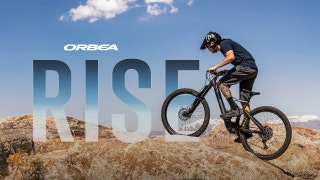Mountain Bars
Along with your pedals and saddle, mountain bike handlebars provide a key rider touch point, influencing steering response, balance, and control of your bike. This is also where all your key cockpit controls are mounted, including grips, brake and shift levers, GPS devices, dropper post remotes, and sometimes suspension lockout switches or even a bell.
Choosing the best mountain bike handlebars involves several key considerations including intended use, construction material, flat versus riser, width, clamp diameter, and backsweep.
Material choice is primarily a budget consideration, with aluminum mountain bike handlebars typically costing less than their titanium or carbon cousins. Some bars, such as the Thomson Titanium Mountain Riser Bar, also purport to deliver a more compliant, bump absorbing ride, which can mean less hand fatigue, especially during rough descents. Carbon bars are also touted for their shock absorbing abilities, while aluminum options are often considered to be a touch stiffer, but also a tad less forgiving.
As the name indicates, flat bars have little or no rise and are typically reserved for cross-county mountain bikes, where their lower weight and compact position are preferred by racers. Conversely, riser mountain bike bars sweep upward at either end, offering a more upright position, which is generally associated with enhanced comfort and greater steering control while descending.
Mountain bike bars width typically ranges from 680mm to 800mm, with cross-country riders preferring narrower (and thus lighter) bars, while gravity enthusiasts lean toward the wider end of the spectrum because of the extra leverage and steering control. Many mountain bike handlebars come with graduated cut marks on the ends so you can accurately trim as needed. Just remember once you cut you can’t go back, so make sure you’ve identified your ideal width before going to work with the hacksaw.
The most common clamp diameter is 31.8mm, but 35mm options are also available primarily for gravity-focused riders who appreciate the extra stiffness. Just remember that whichever clamp diameter you choose will need to match your stem, so be sure to double check.
Rise is another personal preference. Flat bars have just a few millimeters of rise, while riser bars can climb upwards of 30mm. Taller bars typically have a more precise steering feel, but some riders may not like the upright riding position.
Lastly, back sweep is reference to the degree of rearward sweep from your mountain bike handlebars center line. Increased backsweep can enhance wrist and shoulder comfort. But as with most of these metrics, it usually comes down to personal preference.
If you have any questions about mountain bike handlebars, give one of our JensonUSA Gear Advisors a call today at 888-880-3811. They’ll be happy to guide you through the decision process.
































































































































































































































































































